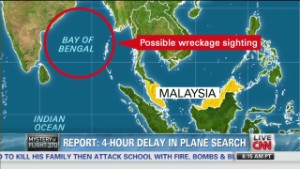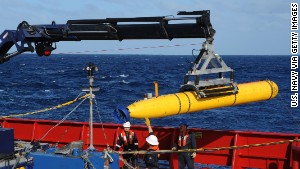MH370: Search for plane enters new, 'more difficult' $60 million phase
updated 7:45 AM EDT, Mon May 5, 2014
STORY HIGHLIGHTS
- Officials will review data to see if satellite information has been "accurately interpreted"
- More high-tech devices will be used over an expanded search area
- The search area will expand to deep water that has "never been mapped"
- Australia estimates the next phase will cost $60 million
(CNN) -- More than 300 flights.
Over 3,000 hours in the air.
A staggering 4.6 million square kilometers of ocean.
The numbers speak to the breadth of the search for the missing Malaysia Airlines Flight 370.



The results speak to the fruitlessness of it.
The plane, carrying 239 people, disappeared on March 8. And despite an expansive search involving 26 countries, officials have nothing to show for it.
So authorities are moving on to the next phase of the search -- one that will be even more challenging.
"We know very clearly the area of the follow-up search will be even broader, with more difficulties and tougher tasks," Chinese Transport Minister Yang Chuantang said Monday.
What's next
Australian, Malaysian and Chinese officials will meet in Canberra, Australia, on Wednesday to hash out plans for the next stage of the hunt.
One group will analyze the data and information collected so far. Another will look at the resources needed.
The data audit will look at information gathered since the beginning of the search.
"It will also look again at the satellite information that's been accumulated so that we can make sure that it's been accurately interpreted," Australian Deputy Prime Minister Warren Truss said.

Authorities have relied on satellite information and pings believed to be from the plane's flight data recorders in picking their search area.
But with an expanded search area comes the most challenging task ahead: scouring uncharted territory.
A key element of the new phase will be a detailed mapping of the ocean floor.
"We know that the water is very deep," Truss said. "And for the next stage involving sonar and other autonomous vehicles, potentially at very great depths, we need to have an understanding of the ocean floor to be able to undertake that kind of search effectively and safely."
Truss said he's not sure how deep the ocean is in the expanded search area because "it's never been mapped."
The tools
The next stage of the hunt will involved highly specialized technology, including towed side-scan sonar and more autonomous underwater vehicles, Truss said.
"You can count on one hand the number of devices that can do this work, when you talk about towed sonar devices," said Angus Houston, chief coordinator of the joint search effort.
Truss said he's optimistic that the new devices will be in the water within a month or two. In the meantime, he said, the Bluefin-21 drone will continue underwater missions.
The Bluefin-21 has already scanned 400 square kilometers of the Indian Ocean floor, but with no luck. The United States has authorized the use of the drone for another month. The cost? About $40,000 a day.
While the Bluefin-21 provides greater resolution than deep-towed sonar devices, the drone can only go about 4.5 kilometers deep.
The cost
Australia estimates the next phase of the search will cost about $60 million, Truss said. He said officials will consult with Malaysia, China and other parties on how that cost would be shared.
Until now, all countries involved in the search have paid for their own costs.
"Whenever we've asked, people have come forward," Truss said. But "I think we'll be looking at increasing involvement from the manufacturers and their host countries."
Letting others in
The new phase will allow more parties to join the search, acting Malaysian Transport Minister Hishammuddin Hussein said.
"This gives an opportunity to those not involved in the early phase of the search and rescue efforts to come on board," he said.
Those could involve research institutions and more countries, he said.
Truss said most of the new equipment will likely have to come from the private sector.
Lessons learned
It took two years to find the wreckage of Air France Flight 447 in the Atlantic Ocean.
Truss said authorities can learn from that effort.
"There were some quite long gaps in their search, and we don't want that to happen in this instance," he said. "That's why we're starting work this week on actually putting together the next stages of the search."
But as officials from this search have already learned, hope can dash as quickly as it arises.
"We've been confident on the basis of the information provided that the search area was the right one," Truss said. "But in practice, that confidence has not been converted into us discovering any trace of the aircraft."
CNN's Will Ripley and Christine Theodorou contributed to this report.
No comments:
Post a Comment
Thanks for commenting. Your comments are needed for helping to improve the discussion.